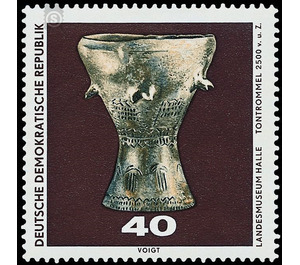Archaeological finds in the GDR - Germany / German Democratic Republic 1970 - 40 Pfennig
Theme: Post & Philately
| Country | Germany / German Democratic Republic |
| Issue Date | 1970 |
| Face Value | 40.00 |
| Color | brown |
| Perforation | K 13 |
| Printing Type | Photogravure |
| Stamp Type | Postage stamp |
| Item Type | Stamp |
| Chronological Issue Number | 1298 |
| Chronological Chapter | GER-DDR |
| Michel ID | DDR 1556 |
| SID | 187927 |
| In 19 Wishlists | |
Archaeological finds in the GDR The Ministry of Posts and Telecommunications of the German Democratic Republic issues four multi-colored special postage stamps with illustrations of archaeological finds in the GDR from the State Museum of Prehistory in Halle. Archaeological research in the German Democratic Republic has achieved many new and sometimes surprising results in recent years, which provide information about the life and activities of prehistoric man on the soil of the GDR. The GDR is one of the few states in the world in which the prehistoric and protohistorical landlords enjoy legal protection (Ordinance on the Protection and Preservation of Prehistoric and Early Historical Landscapes, 1954). One of the leading archaeological research centers in the GDR is the Landesmuseum für Vorgeschichte Halle (Saale), which enjoys a reputation far beyond the borders of our country and maintains international connections with similar research institutions on all continents. From the rich find of the Landesmuseum for prehistory Halle four objects were selected as motives for stamps, which are of special cultural-historical meaning. 40 Pfennig value Tontrommel 2500 v. u. Ztr For more than 6,000 years, drums have been known all over the world, but the drums made of clay in the Neolithic period are a curiosity within the European Stone Age. Their main distribution is in the Saale area. Unfortunately, the eardrum was not preserved in any case. But you can tell from the spigot attached to the drum, how the tension of the coat was made. The sound drums were used in the Neolithic period primarily as rhythmic sound instruments. Since many of the sound drums are decorated with symbols (sun sign, cross, tree of life, ear symbol), it can be assumed that the drums should guide the steps of the dancers during religious rites. In addition, there is the possibility that the Neolithic people used the drums as signal instruments for transmitting messages. Location of the sound drum used as a motif: Leuna-Rössen, Merseburg district.
| Condition | Name | In Stock | Price | Price + Shipping | Store | |
|---|---|---|---|---|---|---|
 | Unmounted Mint ** | Archaeological finds in the GDR - Germany / German Democratic Republic 1970 - 40 Pfennig | 1 | US $0.113 | US $7.66 |  willcolector (0) willcolector (0)Shipping US $7.55 |
 | Used | Archaeological finds in the GDR - Germany / German Democratic Republic 1970 - 40 Pfennig | 1 | US $0.113 | US $7.66 |  willcolector (0) willcolector (0)Shipping US $7.55 |


